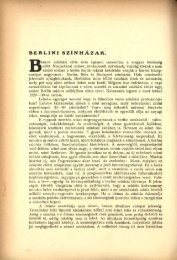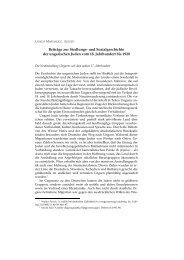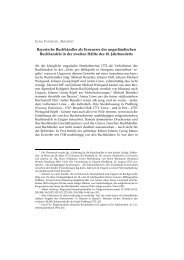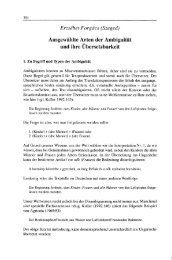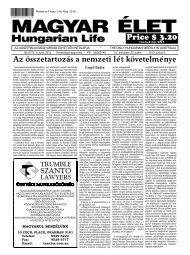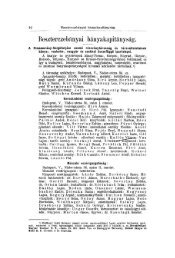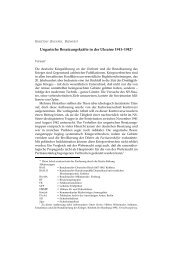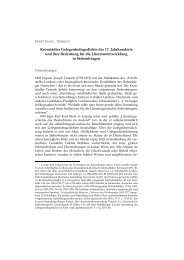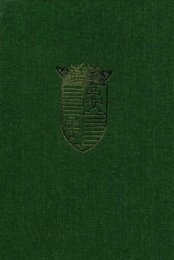Osservatorio letterario ANNO 14. – NN. 73/74 MARZ.-APR./MAGG ...
Osservatorio letterario ANNO 14. – NN. 73/74 MARZ.-APR./MAGG ...
Osservatorio letterario ANNO 14. – NN. 73/74 MARZ.-APR./MAGG ...
You also want an ePaper? Increase the reach of your titles
YUMPU automatically turns print PDFs into web optimized ePapers that Google loves.
Orkhon relics; циньча (Cinch’a) in the Chinese<br />
chronicles; половцы (Polovets) in the ancient Russian<br />
chronicles; куманы, куны, палоцы (Kumans, Kuns,<br />
Palots in the work of Bízantine and Western authors;<br />
etc. Sometimes there are fierce debates among the<br />
researchers dealing with these questions, about the<br />
following type of problems: What was the name of this<br />
or that people, ethnic group, tribe at the beginning?<br />
Are there any connections between the ancient name<br />
and that denomination which might have preserved (or<br />
might have changed) its form up to our days? The fact<br />
that an ethnonym does not change for a long historical<br />
period can tell us not only about the stability of the<br />
given ethnic name, but also about the durability of the<br />
historical remembrance of the carriers of it: their the<br />
remembrance about their past, their ancestors, their<br />
leaders, about the founders of their clans, etc.<br />
In my opinion the posed questions referring to<br />
the ethnonym of the medieval Magyars (denomination:<br />
Magyar, Megyer, (in Russian: мадьяры, венгры, угры,<br />
in other European languages: Hungarian, Hongroise,<br />
Ungarn, etc.) belong to the above mentioned group of<br />
problems. According to the data at our disposal, the<br />
“Magyar” ethnonym was first mentioned in Arabic<br />
written sources. In the work of Ibn Rusta, titled to<br />
“Kitab al-alak an nafisa”, (written around 903 A. D.),<br />
the Magyars’ name appears in the form of “al-<br />
Madžariya” (al-Maggariya). If we take away from this<br />
word the Arabic article “al” and the suffix “iya”, we can<br />
recognize the “Magyar” name. Another Arab author, Al-<br />
Bekri describes the country of the “Madžars”<br />
(Maggariya, al-Madžarija, or Bilad al-Maggariya). In the<br />
10<strong>–</strong>11 th Centuries the Persian authors also gave<br />
account about the Madžars (Magyars). For example,<br />
there is a description of the country “Maggari”, situated<br />
in the West, in the “Hudud al-alam” (a Persian anonym<br />
geographic work). In the work of al-Gardizi (Zayn alakhbar,<br />
11 th C.) the Magyars were also called “Maggari<br />
(or Maggariyan in plural numbers.). In late medieval<br />
and modern Russian written sources the following<br />
forms of this ethnonym can be noticed: Madžar/Magar<br />
<strong>–</strong> Možar, Mažar [Levickij, 1978, pp. 56<strong>–</strong>60].<br />
A pre-Revolutionary Russian author, D. A.<br />
Khvolson systematized the information about the early<br />
medieval Magyars. He brought forward a hypothesis<br />
according to which the Magyar (Madžar) and the<br />
Bashkir (Bashgard) ethnonyms have common roots. He<br />
says that the original form of this term had been<br />
“Badzghard” which developed later as follows:<br />
Bashgard <strong>–</strong> Badžgar<br />
Bashkard <strong>–</strong> Modžgar<br />
Bashkart<strong>–</strong> Madžgar<br />
Bashkert <strong>–</strong> Madžar<br />
Bashkirt <strong>–</strong> Magyar<br />
Bashkir [Khvolson, 1869, p. 1<strong>14.</strong>]<br />
It is not perfectly understandable how the letter<br />
“B” changes to “M” in the quoted reconstruction. The<br />
idea of D. A. Khvolson was and is copied and repeated<br />
everywhere and is “wandering” from one scientific work<br />
into the other. It became an indisputable fact for a<br />
certain circle of researchers. I accept the arguments of<br />
D. Khvolson about the ethnic relation of the medieval<br />
Magyars and Bashkirs. However, I must tell that the<br />
terms of “Magyar” and “Bashkir” have no linguistic<br />
contacts. The two denominations bear different ideas,<br />
therefore, they have different meanings.<br />
R.G. Kuzeev <strong>–</strong> referring to the researches of Lotz<br />
[1956, pp. 679<strong>–</strong>680], points at three words from the<br />
family of words “Magyar”: 1) mogyer <strong>–</strong> the country of<br />
the Magyars; 2) mogyar <strong>–</strong> personal name (name of a<br />
leader); and megyer <strong>–</strong> ethnonym. Besides, the root of<br />
the word: the syllable mod refers to the country or to<br />
the Magyar people; but med is the fundament of the<br />
denomination of that tribe (Magyar), which gave the<br />
name of the Hungarians. [http://shejere.narod<br />
ru/kuzeev]. According to the opinion of the famous<br />
philologist, V. V. Napol’sky, “the self-denomination of<br />
the Hungarians, the Magyar < mažar (equal of the<br />
ancient Hungarian tribe name “megyer


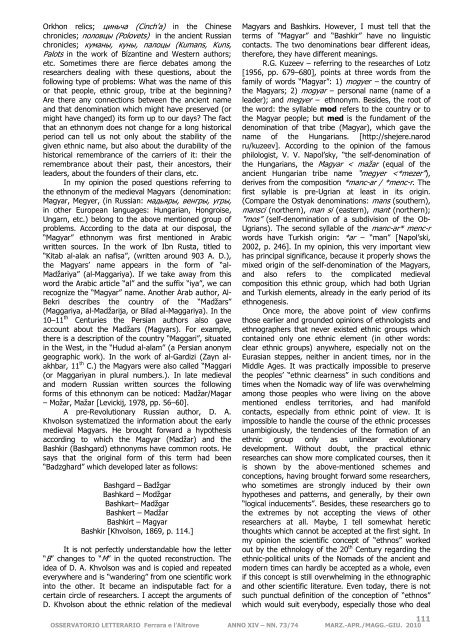
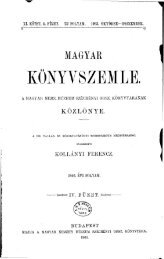
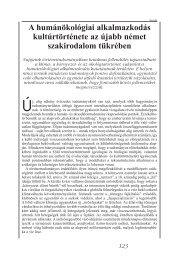
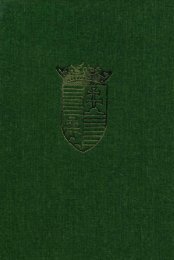
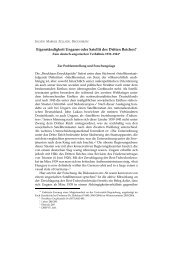
![Letöltés egy fájlban [36.8 MB - PDF] - EPA](https://img.yumpu.com/23369116/1/172x260/letoltes-egy-fajlban-368-mb-pdf-epa.jpg?quality=85)
